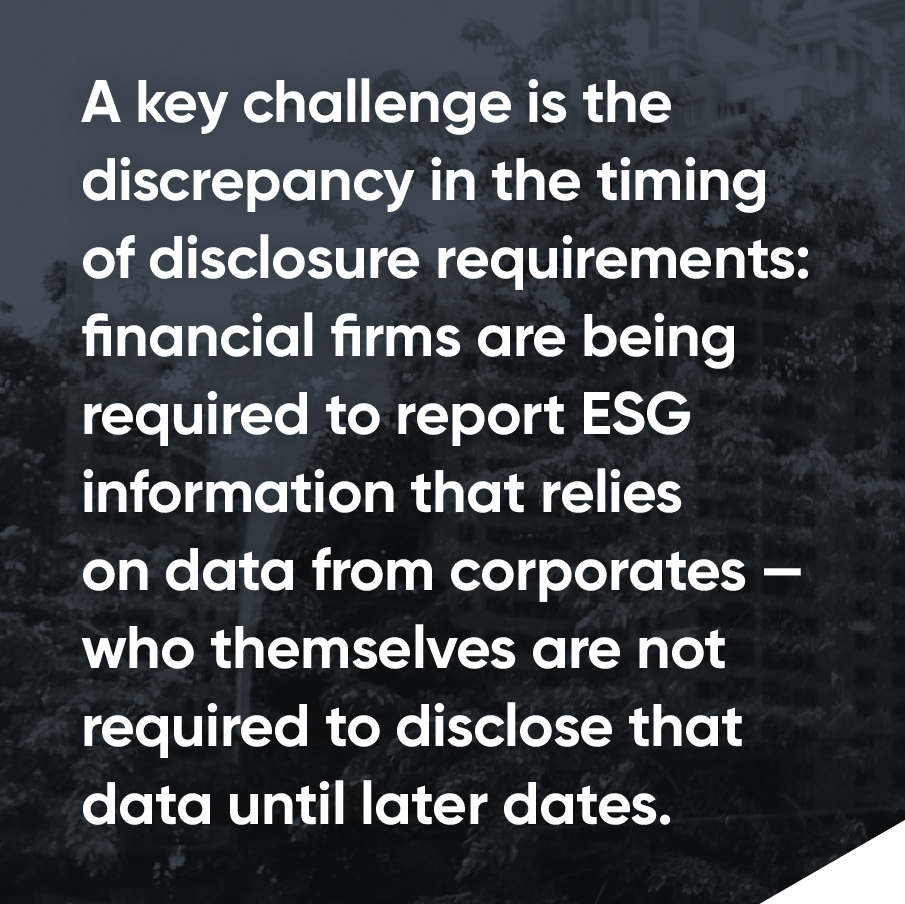Where do the ESG regulatory reporting regimes stand today? And what impacts will they have for market participants and investors?
The major impacts of the EU’s SFDR expansion
The EU’s comprehensive sustainable finance plans aim to provide a common definition of sustainable activity, mandate companies to integrate sustainability and risks in their management and disclose their impact in the market environment. Its goals are to:
- Provide greater transparency on ESG investment products
- Use a taxonomy to set a common definition of sustainable activity
- Set market standards for financial products including green bonds, benchmarks and eco labels
The EU’s aggressive timeline, which began in early 2021, stretches over the next several years.
Starting January 1, 2023, requirements will expand to require adherence to technical reporting standards, for pre-contractual and periodic disclosures at product level, as well as website disclosures at both entity and product level. Starting in June 2023, website disclosures at the entity level, addressing principal adverse impacts, must consider the first reference period (the calendar year 2022).
In addition, under the Taxonomy Regulation, beginning on January 1, 2023, non-financial firms must address key performance indicators for alignment with the Taxonomy Regulation.
A key challenge is the discrepancy in the timing of disclosure requirements: financial firms are being required to report ESG information that relies on data from corporates — who themselves are not required to disclose that data until later dates.
The future of ESG in the UK and the US
 In the UK, similar disclosure and reporting regulations are developing, with the UK already having fully embraced the FSB’s Task Force on Climate-Related Financial Disclosures (TCFD) recommendations released in 2017 for the pension fund industry. By the end of 2021, TCFD supporters spanned 89 countries and jurisdictions with a combined market capitalization of over $25 trillion — a 99% increase over 2020, according to the FSB.
In the UK, similar disclosure and reporting regulations are developing, with the UK already having fully embraced the FSB’s Task Force on Climate-Related Financial Disclosures (TCFD) recommendations released in 2017 for the pension fund industry. By the end of 2021, TCFD supporters spanned 89 countries and jurisdictions with a combined market capitalization of over $25 trillion — a 99% increase over 2020, according to the FSB.
Structured around four thematic areas representing core elements of how companies operate — governance, strategy, risk management, and metrics and targets – plus 11 other interrelated and supported disclosures – TCFD builds out an information framework to help investors assess climate-related risks and opportunities.
The US has also issued climate-related disclosure requirements for both financial firms and issuers. Based on global frameworks such as the TCFD recommendations and the GHG Protocol, the SEC-authored rules are scheduled to be implemented in stages beginning in 2023 and require specific climate-related data to be provided in registration statements, periodic reports, fund prospectuses and other filings.
The path to more ESG data – and transparency
Government policymakers and the private sector appear to be more aligned in the EU and the UK than in the US, where the SEC’s proposal could face more skepticism. Yet regardless of the maturity level of regulations in each region, they represent positive developments: harmonizing climate-related disclosures, enhancing investor transparency through key performance indicators (KPIs), and consolidation of different standards for ESG ratings.
Over time, as more companies engage with ESG initiatives and participate in the reporting process, consistency and normalization of disclosures will improve. Sustainable action plans and regulatory reporting will generate more data to assist all parties with assessing companies’ performance and drive regulatory reporting. Investors will also benefit from more information on how well their sustainable preferences and requirements align with their investment portfolios.
Disclaimer: The information contained in this communication is for informational purposes only. Confluence/StatPro is not providing, legal, financial, accounting, compliance or other similar services or advice through this communication. Recipients of this communication are responsible for understanding the regulatory and legal requirements applicable to their business.